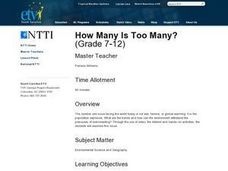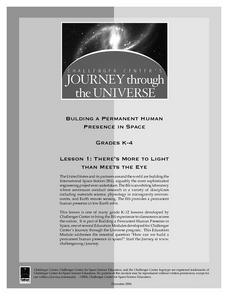Curated OER
Organic and Inorganic Recycling
Students examine their role in polluting the environment and discuss the importance of recycling. In groups, they place earthworms into compost piles to observe why they are considered natural recyclers. They also practice sorting a...
Curated OER
Sound for Sight
Students study echolocation and understand how dolphins use it to locate prey, escape predators, and navigate their environment. They view a video, "In the Wild-Dolphins with Robin Williams" and see first hand how dolphins communicate. ...
Curated OER
Make Your Own Recycled Paper
Paper Lesson Plan - Students discover how paper is made. Working together, they make their own paper. This activity introduces students to recycling; what it is and its importance. Students study the process of how paper is made, and...
Curated OER
PUBLIC POLICY AND THE GOVERNMENT
Learners analyze the pros and cons of public policies. They analyze how public policy issues are influenced by government actions (e.g., transportation, the environment). They research the elements and requirements of the...
Curated OER
The World's Tallest Building
Students investigate the world's tallest buildings. In this architecture lesson plan, students discover how humans change the physical environment. Students read about and view pictures of famous buildings in the world. Students make...
Curated OER
Draw an Alien in Natural Habitat
Students apply prior knowledge of living things, structures of living things and how living things sense and respond to their environment. In this habitat lesson, students review the basic needs of organisms to survive. Students create...
Curated OER
Natural Forces
Students assess the damage natural forces have caused Maryland's geographic features. In this state geography and ecology lesson, students work in a group to research ways in which weathering, erosion, and deposition have affected the...
Curated OER
Cherishing the Water of Life
Learners work in small groups to brainstorm a list of all creatures, plants, natural, and artificial processes that use or depend on fresh water. The class views an aquarium filled with water representing all the water in the world. The...
Curated OER
Evolution
In this evolution instructional activity students complete a crossword puzzle by answering questions about the environment, evolution and populations.
Curated OER
Biodiversity Study -- A Unit Study
Learners sample a site with low human impact, one with moderate human impact, and a third with high human impact. Students chart the data for each site and then compare the sites and discuss.
Curated OER
Giraffe Riff Raff
Students study the effects of wildlife conservation and relocation. In this conservation lesson students view video on the preservation of the giraffe populations and discuss the impact that humans have had on them.
Curated OER
Scientific Inquiry, Episode 1
Students look at ways to help the environment. In this recycling lesson, students watch a video on pollution and then collect trash at their school. They create posters to share with the school about the importance of recycling.
Curated OER
I See a Coyote
Students role-play coyotes looking for natural resources. In this natural resources lesson, students examine the relationship between animal life and the environment. Students play a game that demonstrates how natural resources affect...
Curated OER
Ecology
Students make connections between their daily lives and the usage of natural resources as they relate to the importance of environmental quality. In this ecology lesson, students listen to the story The Lorax by Dr. Seuss and then...
Curated OER
Symbiotic Strategies
Students explore the different interspecies relationships namely mutualistic, commensal and parasitic. For this ecology lesson, students investigate an ecosystem disrupted by humans. They formulate an action plan to save it and present...
Curated OER
Alaska
Students describe and explain variations in Alaska's physical environment including climate, landforms, natural resources and natural hazards and compare how people in different communities adapt to or modify the physical environment.
Curated OER
Water Cycle (Grades 2-4)
Students demonstrate their understanding of the water cycle and how it effects the environment by graphically depicting and describing the water cycle.
Curated OER
Taking a Stand: Pros and Cons of Forest Fires
Learners explain the components of fire, explain how forest fires impact man and the environment, analyze data in order to recognize areas that are at risk for forest fires, make recommendations based on research.
Curated OER
Flowering Phenology: How Do Plants Know When To Flower?
Students explore the biotic and abiotic factors that affect plant reproduction and the potential consequences of human activities on plant populations. The effects of urbanization are discussed as an influence in the consequences.
Curated OER
EPA's Superfund Program
Students work together to gather information about the EPA's Superfund program. They discuss how to improve human health and the environment. They discover how hazardous wastes are characterized and cleaned up.
Curated OER
Construct And Test Roofs for Different Climates
Students investigate what types of roofs are appropriate for various types of climates and environments. They discuss and observe different types of roofs and housing, listen to the book "Houses and Homes," select a region, and design...
Curated OER
Water-The Liquid Gold
Learners investigate the necessity of water for the survival of plants, animals, and people. They explore the affect that water has on human and natural environments through literature, field trips, and discussions.
Curated OER
How Many Is Too Many?
Students explore the population explosion. They view a video depicting the exponential growth of human population. Students research the internet to project future population data. They perform hands-on, multimedia activities to study...
Curated OER
There's More to Light than Meets the Eye
Students explore the concept that not all light is visible to the
human eye. Although UV light is not visible, it can still be harmful, causing sunburns or skin cancer. They use special beads to detect UV light around the school....
Other popular searches
- Human/environment Interaction
- Geography Human Environment
- Human Environment Interaction
- Human Environment in Peru
- Human Environment Relations
- Human Environment Vietnam
- Human Environment Africa
- Human Environment Asia
- Human Environment Community
- Human Environment School
- Human Environment Problems
- Human Environment Interaction

























